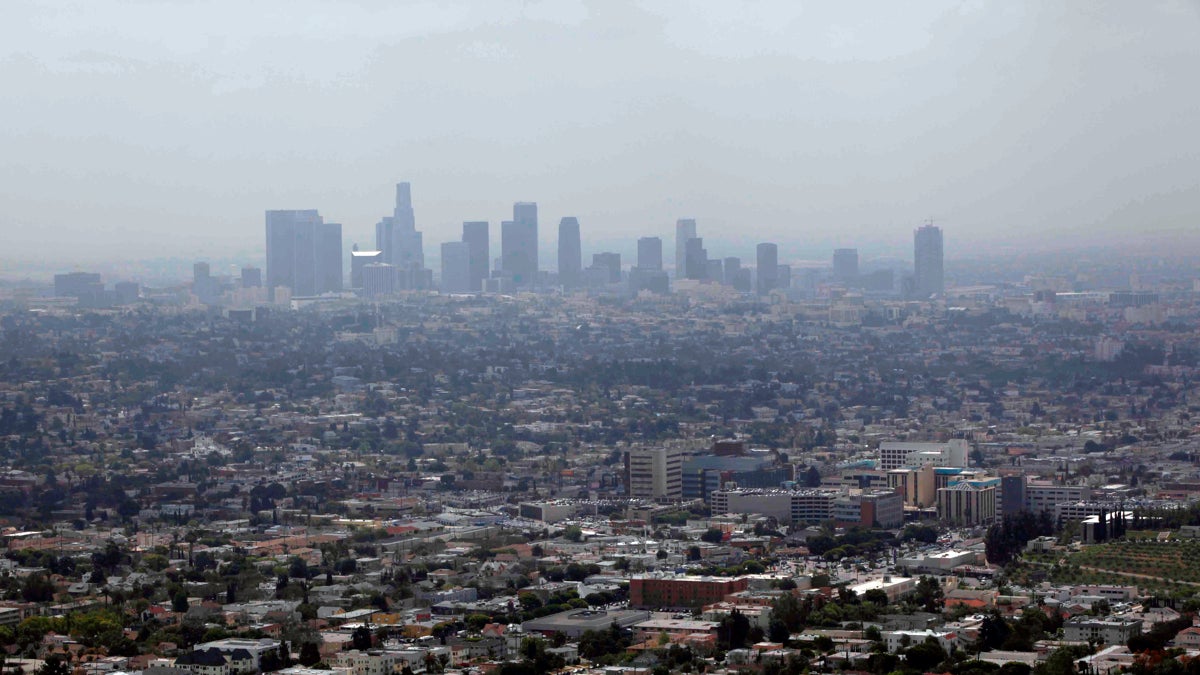Obama’s EPA versus the party of pollution

Smog covers downtown Los Angeles in this 2009 file photo. (AP Photo/Nick Ut)
Let us return, albeit briefly, to those distant days when curbing pollution was a bipartisan cause celebre.
Ladies and gentlemen, the President of the United States:
“Our national government today is not structured to make a coordinated attack on the pollutants which debase the air we breathe,” he wrote, as he announced a “reorganization order” creating an Environmental Protection Agency. “The EPA would have the capacity to do research on important pollutants…and on the impact of these pollutants on the total environment. With these data, the EPA would be able to establish quantitative ‘environmental baselines’ – critical if we are to measure adequately the success or failure of our pollution abatement efforts.” This way, the EPA can “set and enforce standards.”
So said Richard Nixon, a Republican. His party allies on Capitol Hill supported his executive order. And when the Clean Air Act – the legal template for the EPA’s mission – went to the Senate floor, not a single Republican voted nay. And at the signing ceremony, Nixon lauded the law as “a bipartisan effort represented by senators and congressmen, who are here today….It is only the beginning, because now comes the enforcement….I think that 1970 will be known as the year of the beginning, in which we really began to move on the problems of clean air.”
Imagine that: A Republican president – nutty as a fruitcake in some ways, shrewdly centrist in other ways – creating a landmark environmental enforcement agency, with unanimous Senate backing from fellow Republicans. No obstructionist tricks. No tea-partying bilge. No shutdown brinkmanship.
I’ve conjured 1970 to contrast it with 2014. Today, inexplicably, fighting pollution has become a partisan issue. The GOP has moved so far rightward that Nixon’s agency has become a lightning rod for every Chicken Little industrialist and government-hating ideologue. Just take a look at how they’ve all reacted, this past week, to the EPA’s announcement that it intends to crack down harder on smog.
Who could possibly be opposed to toughening the standards on ozone pollution? To reflect the latest scientific research, and to protect public health, the EPA wants to lower the legal threshold from the current 75 parts per million all the way down to 65 parts per million (or maybe closer to 70; the exact number hasn’t been set yet). And the EPA, citing the latest science stats, says that a tougher ozone rule would trigger major health benefits beginning 10 years from now – most notably, 960,000 fewer asthma attacks in children, 4,300 fewer premature deaths, 180,000 fewer worker sick days, and up to a million fewer student sick days.
Who could possibly be opposed to helping sick kids and sick workers? Who could possibly be opposed to helping the economy and the health care system? According to EPA estimates, reducing smog-related illnesses and sick days would save as much as $13 billion in 2025 if the federal ceiling is 70 parts per billion, and as much as $38 billion if the ceiling that year is 65. Who could possibly be opposed to all these societal benefits?
Cue the partisan jerking of knees.
Two Republican senators, David Vitter and James Inhofe (the latter calls climate science a “gigantic hoax”), declared last week that the EPA’s crackdown on smog would be “devastating” to the free market, “one of the costliest rules ever.” Fred Upton, who chairs a key House energy committee, called it “the most expensive rule ever imposed by the agency.” Mitch McConnell, weeks before the EPA announced its intention to tighten the smog standard, vowed that he will “try to do whatever I can to get the EPA reined in.” And so on.
It’s tiresome to hear the Cassandra chorus crank it up again; fortunately, the chorus can’t do all that much to stop progress. The U.S. Supreme Court has broadly signaled, numerous times, that the EPA has the authority not only to protect public health, but to prioritize health over industry cost. The Clean Air Act says that the EPA’s air quality standards shall “protect the public health” with “an adequate margin of safety.” Even Justice Scalia, in a 2001 opinion, looked at the law and concluded: “Nowhere are the costs of achieving such a standard made part of that initial calculation.”
But the thing is, EPA’s critics have long been exaggerating those costs.
To cite one random example, I’m old enough to remember the mid-’70s, when energy titans and conservatives complained that the EPA’s planned crackdown on leaded gasoline would make the fuel unaffordable at the pump for the average Joe. But what typically ends up happening is that industries find ways to adjust – with technological prowess – during the long rule implementation phase. And as the nonpartisan Congressional Research Service now predicts, referring to the new smog rule, “Technological advances over time will tend to increase the economic feasibility of reducing emissions, and will tend to reduce the costs of reducing emissions.”
Today, unleaded gas is a given. (According to the Centers for Disease Control, lead levels in children’s blood have fallen 98 percent in the last 35 years.) Today, the air is notably cleaner than it was when Nixon acted in sync with fellow Republicans in a bipartisan Congress. And yet, today’s GOP right-wing ideologues – goaded, naturally, by the Koch brothers and their other fossil-fuel donors – behave as if that 1970 milestone never happened.
All of which prompts a thought: If one’s aim is to woo the American middle, Is there really an upside to being known as the party of pollution?
——-
Follow me on Twitter, @dickpolman1, and on Facebook.
WHYY is your source for fact-based, in-depth journalism and information. As a nonprofit organization, we rely on financial support from readers like you. Please give today.

